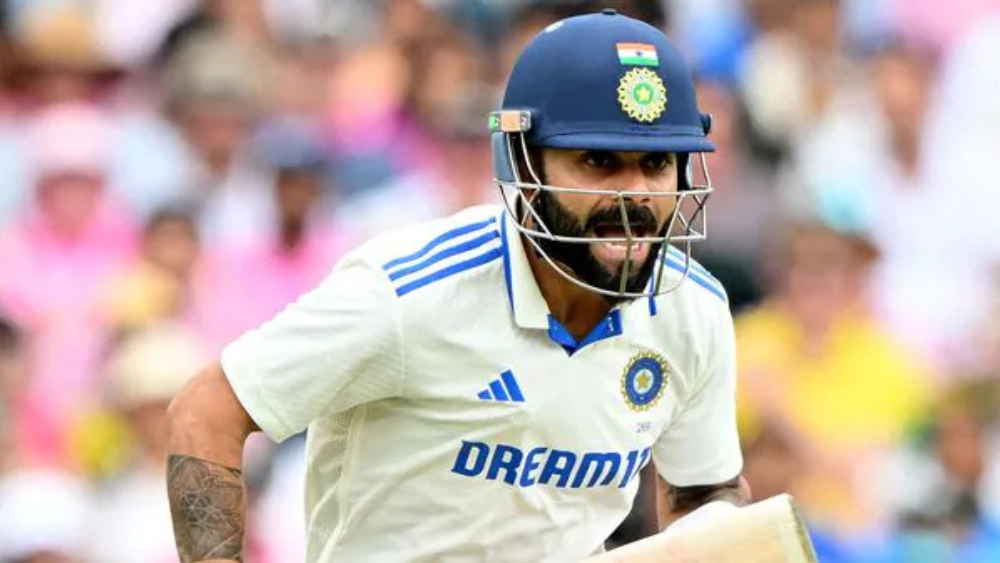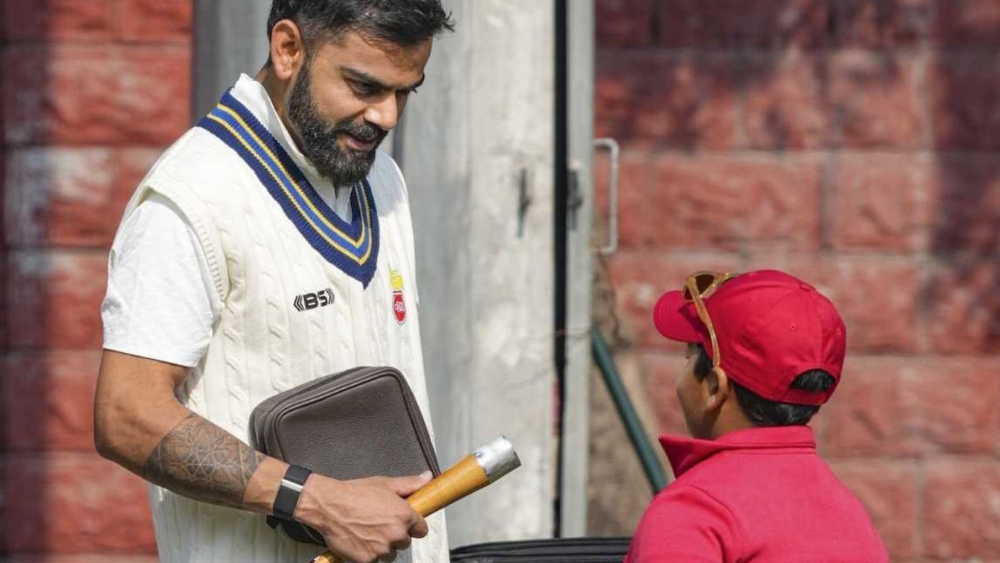“Virat Kohli’s inspiring advice to a young boy at Ranji Trophy training highlights the importance of self-motivation, hard work, and dedication to cricket.”
Table of Contents
A Grand Arrival: Kohli Returns to His Roots
At precisely 9 a.m., the familiar hum of a jet-black Porsche echoed through the iconic Virender Sehwag Gate at the Feroz Shah Kotla Ground. As the luxury car rolled in, the excitement among onlookers was undeniable. It was a homecoming for Delhi’s very own cricketing icon, Virat Kohli, as he returned to train with his first-class team after more than twelve long years.

The Impact of Kohli’s Presence on the Delhi Team
For Delhi’s current squad, the experience was surreal. With the exception of fast bowler Navdeep Saini, none of the 18 players had ever played alongside Kohli. They had only seen him on television or heard stories about how a young, determined ‘Cheeku’—as he was fondly called—emerged from Delhi’s cricketing circuits to become the ‘King’ of Indian cricket. Over the past fifteen years, the boy from Delhi had evolved into a global sports phenomenon, the very face of cricket, so much so that the International Cricket Council (ICC) used his image for its Olympic bid presentation.
The Electrifying Atmosphere at Kotla
For over three hours, Kohli’s presence at the ground left everyone in awe. From aspiring young cricketers to seasoned coaches, every individual near him was spellbound. The seasoned head coach Sarandeep Singh and batting coach Bantu Singh remained close to him, eager to observe his every move. Despite being courteous with all, Kohli seemed most at ease with his former U-19 coach, Mahesh Bhati, who now serves as the administrative manager of the Delhi team.
The Media Frenzy: How Kohli’s Presence Changed the Coverage
Every movement of the star batter was tracked with enthusiasm. The normally sparse media presence at Ranji Trophy matches tripled in size. Such is the power of Virat Kohli—his presence alone was enough to influence streaming platforms. JioCinema, which had initially decided not to stream the game, quickly made arrangements to broadcast it live, recognizing the commercial allure that Kohli brings.
Virat Kohli’s Training Session: Business as Usual
For young cricketers like Sanat Sangwan, Arpit Rana, and Siddhant Sharma, the opportunity to train with Kohli was a dream come true. However, for Kohli himself, it was just another training session. It was evident that he had left his global stardom at the entrance and stepped onto the field as ‘Virat Bhaiya’—a mentor and teammate rather than a celebrity.
A Warm-Up Like Never Before
Before the final match against Railways, the warm-up session lasted a remarkable 35 minutes—the longest the team had spent preparing before a net session. Kohli engaged in a 15-minute game of football, running down the right wing and sharing lighthearted moments with his teammates.
Focused Batting Practice: Refining the Master’s Skills
But once the net session commenced, the focus was absolute. As he approached the nets where Delhi’s young captain, Ayush Badoni, was batting, the nervousness on Badoni’s face was apparent. Sensing this, Kohli immediately reassured him, saying, “Ayush, tu batting karle, phir dono switch karke karenge” (Ayush, you keep batting. After some time, we will take turns to bat). In an act of humility, he had already declined the team’s captaincy for this match, just as Rishabh Pant had done in the previous game and Rohit Sharma had done for Mumbai.
Perfecting His Craft: Kohli’s Batting Strategy
For nearly an hour, Kohli honed his skills in the nets. He began with throw-downs, repeatedly practicing his pull shots. He then moved to the spinners’ nets, facing deliveries from left-arm spinners Harsh Tyagi and Sumit Mathur. Though some balls gripped the surface, there was little in their deliveries to trouble the master batter. He continued his session against fast bowlers Navdeep Saini, Money Grewal, Rahul Gehlot, and Siddhant Sharma, practicing his shot selection and technique.
Adjustments for the Champions Trophy
Unlike the intense India net sessions, Kohli appeared at ease, occasionally leaving deliveries and focusing on his back-foot play. With the upcoming ICC Champions Trophy in mind, he was keen on refining his strokes square of the wicket. Domestic cricket, for him, served as the perfect testing ground before stepping onto the grand stage.
His satisfaction with the training facilities was evident. “Bhaiyya, mazaa aa gaya batting karke. Kal phir aaoonga batting karne” (Brother, I really enjoyed batting here. I’ll come again tomorrow to bat), he told Bhati, praising the quality of the practice wickets, the center strip, and the overall setup.
A Young Fan’s Special Moment with Virat Kohli
Among the crowd of excited onlookers was a fourth-standard student named Kabir, who had arrived with a heartfelt sketch of ‘Uncle Virat.’ What made his visit even more special was the fact that his father, Shavez, had once played U-17 and U-19 cricket for Delhi alongside Kohli.

Kohli’s Friendship with Kabir’s Father
Reminiscing about their younger days, Shavez fondly recalled their trips to pick cricket bats when they had a contract with BDM. Their friendship had spanned years, and now, his young son was face-to-face with the legend himself.
Kohli’s Advice for Future Cricketers
Kabir mustered the courage to ask Kohli a question that has likely been on the minds of countless aspiring cricketers: “How can I play for India?”
Kohli’s response was both simple and profound: “You have to practice hard. And it shouldn’t be your Papa telling you to go to practice. You should tell Papa, ‘I have to go to practice.’”
Key Takeaways from Virat Kohli’s Advice
Kohli’s words resonate deeply with aspiring cricketers and athletes in general. Here are some crucial takeaways from his advice:
Self-Motivation is Key – The drive to succeed must come from within. Nobody else should have to push you toward your goals.
Hard Work and Consistency – There are no shortcuts to success. Consistent practice and dedication are essential.
Discipline and Commitment – A true sportsperson is disciplined, focused, and committed to improving their skills every day.
Embracing Challenges – Kohli himself faced numerous hurdles in his journey but remained steadfast in his pursuit of excellence.
Conclusion: More Than Just a Training Session
As the sun set over Feroz Shah Kotla, one thing became clear—Virat Kohli’s return to his roots was more than just a training session. It was an inspiration, a reminder of where it all began, and a promise that the legacy of Indian cricket continues to thrive through the dreams of young aspirants like Kabir.
His presence at the Kotla ground was a blend of nostalgia and mentorship, serving as a guiding light for young cricketers eager to follow in his footsteps. For Delhi cricket, and for Indian cricket as a whole, Kohli’s homecoming was a testament to the power of passion, hard work, and an undying love for the game.
FAQs
Why did Virat Kohli return to Ranji Trophy training?
Virat Kohli returned to train with Delhi’s Ranji team after 12 years, preparing for upcoming tournaments and inspiring young cricketers.
What was the young boy’s question to Virat Kohli?
A fourth-standard student, Kabir, asked Kohli, “How can I play for India?” seeking guidance on becoming a professional cricketer.
What advice did Virat Kohli give to the fan?
Kohli told him, “You have to practice hard, and it shouldn’t be your father telling you to go to practice—you should tell him you want to go.”
How did the Delhi Ranji team react to Kohli’s presence?
The team was in awe, as many had only seen him on TV. Players and coaches closely followed his training session, eager to learn from him.
What kind of training did Virat Kohli undergo at the session?
Kohli practiced warm-ups, football drills, and batting sessions, focusing on back-foot play and refining shots ahead of the Champions Trophy.
How did Kohli interact with Delhi players?
He encouraged captain Ayush Badoni to bat comfortably and practiced alongside emerging talents, offering insights and motivation.
Why is Virat Kohli called ‘Cheeku’?
Former Delhi Ranji manager Ajit Chaudhary gave him the nickname ‘Cheeku’ during the 2006-07 season, a name that has stuck ever since.
How did Kohli’s presence impact media coverage?
Kohli’s return tripled media attention, and JioCinema, which initially wasn’t streaming the match, made arrangements to broadcast it.
What lessons can cricketers learn from Kohli’s advice?
Self-motivation, discipline, and consistent hard work are key to success—waiting for someone else to push you won’t help in the long run.
How does domestic cricket benefit Kohli?
Playing domestic cricket helps Kohli fine-tune his skills in real match conditions before international tournaments like the Champions Trophy.
By watchnewz
